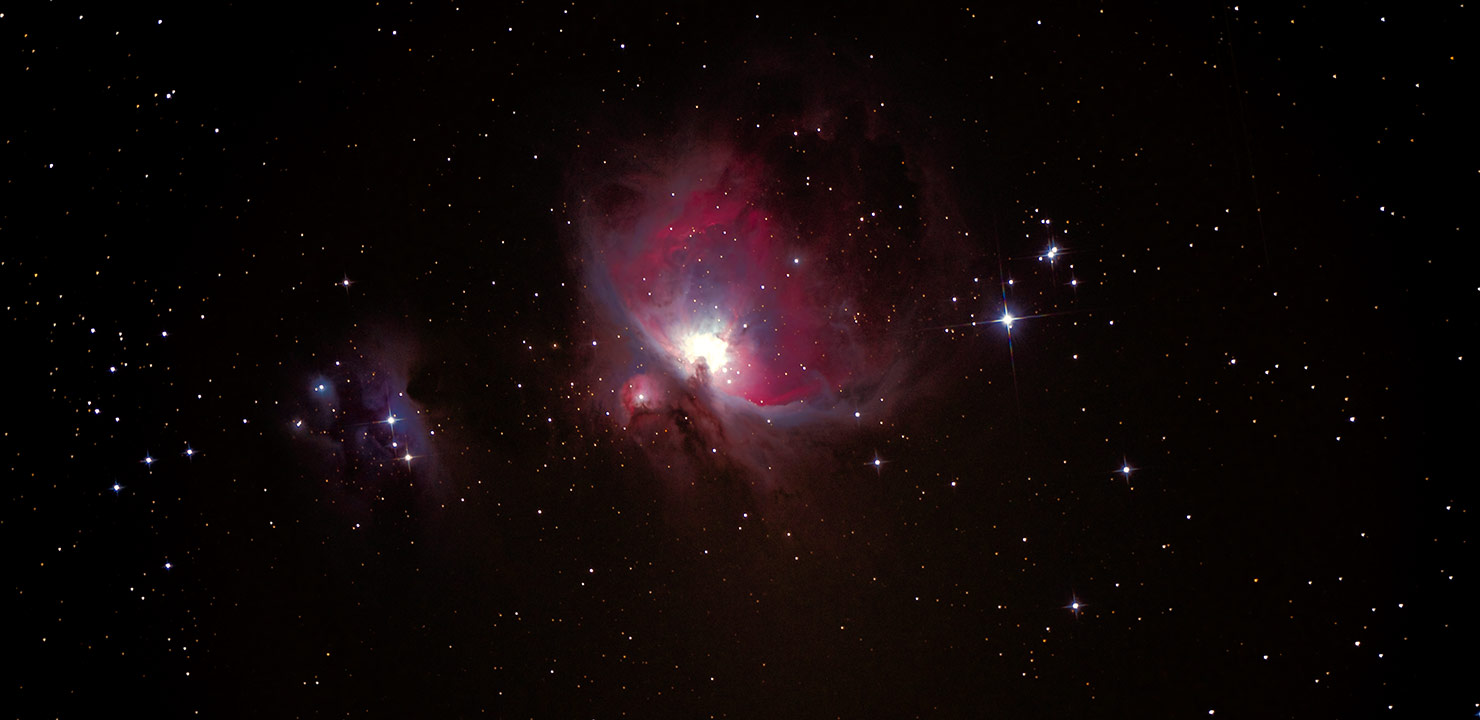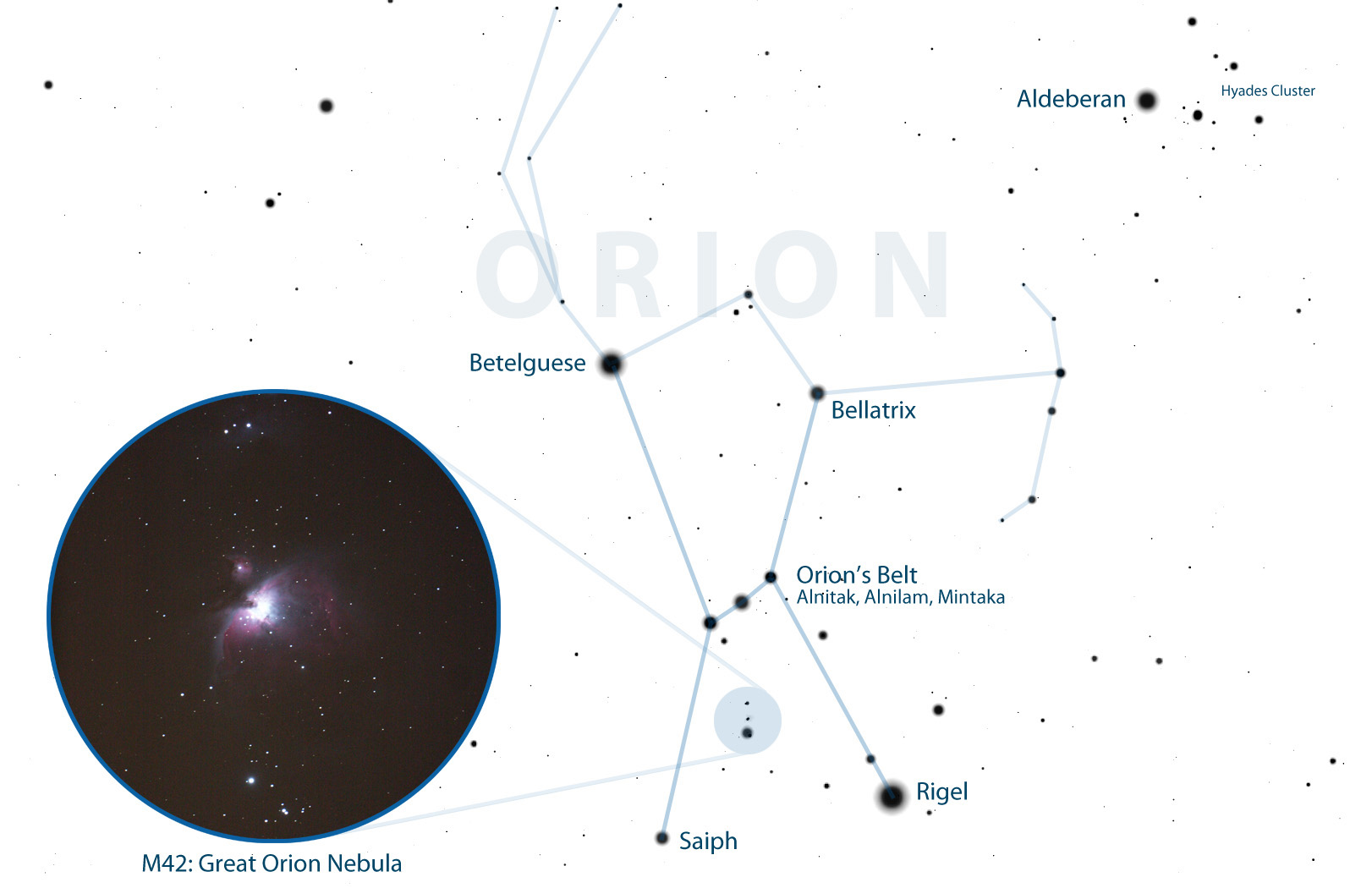
Orion the Hunter
March 2019 :
As the month of March begins, those of you who are early risers will notice a beautiful sight in the eastern sky before dawn. On the 1st brilliant Venus will be about ten degrees above the horizon. About 15 degrees to the upper right of Venus you’ll see Saturn, and two and a half degrees to the upper right of Saturn be a very thin waning crescent Moon. Twenty degrees farther in the same direction you’ll find bright Jupiter. These astronomical bodies appear along this linear arc because it is the ecliptic (the path of the Sun though our sky and the plane of the solar system). This stunning sky scene will be an excellent photo opportunity, so I encourage anyone to capture it.
Everyone with an interest in astronomy probably has a favorite constellation. It may be because of the star pattern’s mythology, its shape in the sky, or for the beautiful objects that reside within its boundaries.
While the months of March, April and May are meteorologically spring months, an astronomer can still observe many of the sky’s prominent winter constellations early in the season. What’s more is that the temperatures outside may be more moderate.
One of my favorite constellations is the most prominent star pattern in the winter sky—Orion, the mighty hunter. However, on March 1 this large constellation, 26th in size, can easily be found about halfway above the southern horizon after sunset. (See accompanying star map.) Though Orion rises on his side, only when he is due south of our location is he standing upright. With the exception of Ursa Major (the Big Dipper) and Scorpius (the scorpion), Orion is probably the most recognizable of star patterns. He is also the brightest of all the 88 constellations.
The mythology of Orion, like many of the older northern hemisphere constellations that date back to the early Greeks and Romans, is quite extensive. The myth I like the most can easily be visualized in the vault of the heavens. Orion fell in love with Pleione, one of the seven sisters known as the Pleiades. To protect the sisters from Orion’s amorous pursuit Zeus placed them in the sky. Though Orion also attained a position in the sky, Zeus positioned Taurus the bull in the sky between Orion and the Pleiades to further thwart his advances. Taurus is recognized by the V-shaped asterism known as the Hyades, with the red giant star Aldebaran marking the bull’s eye. One can easily observe this confrontation to this day as Orion continues to pursue the Pleiades across the sky while fending off the bull.
Before we explore one of the most beautiful celestial objects visible to amateur telescopes (and the determining factor for Orion being one of my favorite constellations), let’s examine some of the major stars that comprise this sky pictogram.

The prominent red star Betelgeuse marks Orion's eastern shoulder (top left, from our perspective) and Bellatrix marks the western one (top right). Betelgeuse, which means “the armpit of the central one,” is a very large red giant star at a distance of 520 light years, measuring in at a conservative 950 solar diameters. It coincidentally resides in a “giant” of a constellation. If you replaced our Sun with Betelgeuse it would extend out to the asteroid belt between Mars and Jupiter.
Blue-white supergiant Rigel resides 800 light years away and is positioned at Orion's western heel (bottom right), while Saiph is at the eastern one (bottom left). Rigel, in Arabic, means “the left leg of the giant.” West of Bellatrix is a curved group of eight stars that represents Orion's shield. Contained within the rectangle formed by Betelgeuse, Bellatrix, Rigel and Saiph is a string of three stars that comprises Orion's belt. Just below the belt you'll find Orion's sword, made up of a small group of stars.
The grandeur of Orion resides in the region of his sword. Using binoculars you'll see a wispy, hazy patch of green light enshrouding the stars. Using a telescope even under low magnification will reveal a greenish tinged nebula of dust and gas, the magnificent Orion Nebula (see photo insert).
You’ll be amazed at the intricate swirls of nebulosity, especially on a moon-less night in a dark country sky. This nebula complex lies about 1,400-1,500 light years distant and is about 30 light years across. You'll also immediately notice four bright stars embedded in the nebulosity. This asterism is called the Trapezium. These four stars are “youngsters” in the universe—only about one million years old. They formed out of some of the gas and dust in the nebula. Approximately 1,000 other stars share a space of about four light years in diameter with the Trapezium stars. That’s crowded real estate!! And more suns will coalesce out of this stellar nursery in the future.
No one has described the humbling effect the Orion Nebula has on us amateur astronomers any better than Garrett P. Serviss in his 1901 book “Pleasures of the Telescope.”
“Nowhere else in the heavens is the architecture of a nebula so clearly displayed. The work of creation is proceeding within its precincts. There are stars apparently completed, shining like gems just dropped from the hand of the polisher, and around them are masses, eddies, currents, and swirls of nebulous matter yet to be condensed, compacted, and constructed into suns. It is an education in the nebular theory of the universe merely to look at this spot with a good telescope. If we do not gaze at it long and wistfully, and return to it many times with unflagging interest, we may be certain that there is not the making of an astronomer in us.”
Did you or one of your family members receive a telescope for Christmas? If bad weather and cold temperatures kept you from observing during January and February, I would suggest that the Orion Nebula be your first celestial target during early March before Orion disappears from view in evening twilight. Then you can decide for yourself whether or not Serviss' description still does justice to the magnificence of this nebula today.
The Orion Nebula looks absolutely wonderful with some of the larger instruments at the local observatories. Don’t forget that March is a transitional month from winter into spring, and here in Southern New England we can experience a wide range of weather. Be sure to check the respective websites for any cancellation notices and observing schedules before venturing out for a visit. Seagrave Memorial Observatory (http://www.theskyscrapers.org) in North Scituate is open every clear Saturday night. Ladd Observatory (http://www.brown.edu/Departments/Physics/Ladd/) in Providence is open every clear Tuesday night. The Margaret M. Jacoby Observatory at the CCRI Knight Campus in Warwick (http://www.ccri.edu/physics/observatory.htm) is open every clear Thursday night. Frosty Drew Observatory (http://www.frostydrew.org/) in Charlestown is open every clear Friday night.
As always, keep your eyes to the skies.
Image of the Sword of Orion, contining the Great Orion Nebula, by Bob Horton using an 8" f/4 Orion astrograph and Nikon SLR.



